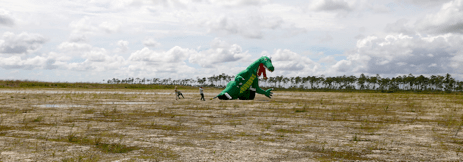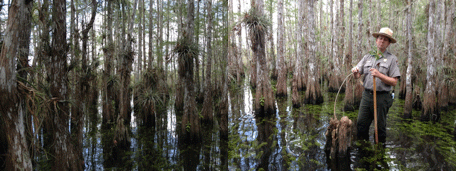
AIRIE Residency: Man and Nature
By Reed van Brunschot, AIRIE
I started my adventure by driving all the way down south to the very tip of America to the small village called Flamingo to meet ranger Ryan to receive my keys for the AIRIELAB studio. There was absolutely no phone service, and it was a nice thought to have life without internet for a while. When it came time to meet with the ranger, I realized was in the wrong location, Way to start it off, Reed. I believe there are no accidents though, and because of this trip I was able to discover the beauties of the Flamingo visitor’s center, a place frozen in time like a Wes Anderson Movie.

I spent time going through each hiking trail and crossing them off one by one, I got a good use out of the mosquito suit a unbeknownst to me September was a heavy mosquito month. There was a lot of joy found in the quietness and isolation in the Everglades. The wind in the trees, the empty roads and the landscape which at first sight looks like the same flat land, but really is so radically diverse.

The AIRIE Team includes biologist Skip Snow, who is a breath of knowledge and inspiration. He was very accommodating host and I felt like I made a real friend. In conversation I mentioned wanting to learn as much as I could of the ‘Glades in order for it to dictate what it needed. Many topics opened up and this offered an opportunity to connect with many more biologists for my research.


It was wonderful observing the unusual phenomenon in the glades; for example vultures picking on rubber car parts in the visitor parking lots like chew toys. This was how my theme of man and nature interactions started. “Who is really the invasive?”
The Park coordinator for AIRIE, Ryan Myer, took me on a slough slog, aka a swamp walk, this is where I really started to understand the majesty and true nature of the Everglades. It was a Dr. Seuss inspired landscape hidden from the rest of the world and the only ones that could comprehend it were those brave enough to wade in alligator infested waters.
The theme of “invasive” kept returning, even when I met with biologist Bryan Falk to talk about the disposal of the invasive caught pythons, we were accompanied by a non-native Mexican tree frog sitting on the dashboard of the research car.

Next up I toured the Archive at the Beard Center with artist and AIRIE Director Deborah Mitchell and archivist Nancy Russell.
Although I found the specimens are fascinating, I was most intrigued with the people and scientists housed in this odd building in the middle of this vast wilderness. This marked the beginning of my experimental projects:
Project Gothic Tourist
Thinking about invasive species had me asking the following questions:
“Who or What is the invasive?” “When do we decide that THIS time and place constitutes as the best example of the natural state which we should preserve?” “Are things not constantly in flux?” Furthermore “Are we not invasives too?”
“What is the line of demarcation of nature and suburban human society as is in Miami?”
I created a character which was a typical suburban outcast, and inserted her in the landscapes of the Everglades where only animals and plants exist. It didn’t matter how I was dressed I was an invasive.


I also thought to go to these very colorful tourist center places and interact with the other visitors would be an interesting juxtaposition of this invasive immersing herself into an environment that was being already being invaded. A double invasive.

Project: Dinosaur
I made a 30 foot inflatable Dinosaur to photograph in this landscape as a typical suburban-like man-made object placed in the wilderness. It is also symbolic of something that once existed there, so it was only fitting to insert it back in Nature, specifically on the old farmland known as hole-in-the-donut. This region was recently stripped bare of invasive plants in an attempt to return it to its original state.
Overall my theme of Man and Nature reigned through. All of my projects inspired and allowed me to make great sketches and works in the Everglades. But being a Miami Resident allows me the luxury of returning in the coming months to make even more concepts yet unrealized.
Reed will speak on the AIRIE panel entitled Science + Art: Transformative Experiences in the Everglades at The Swamp during the Miami Book Fair, Tuesday, November 18th@7pm.
Recent Content
-
Artsarticle ·
-
Artsarticle ·
-
Artsarticle ·
